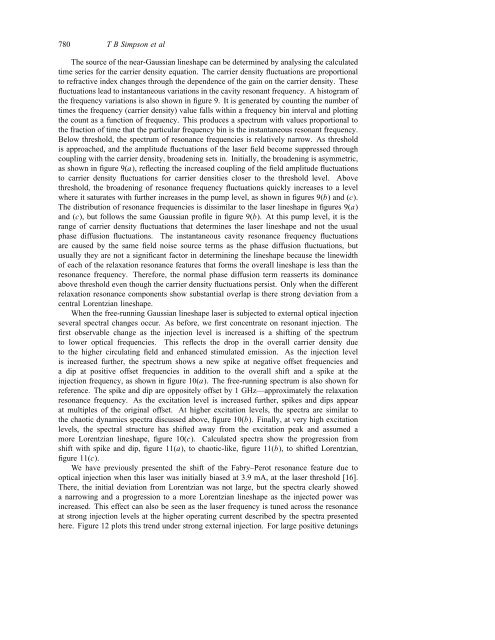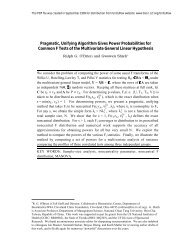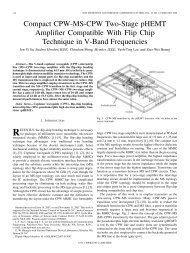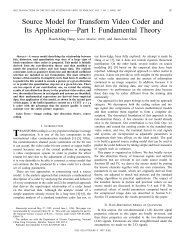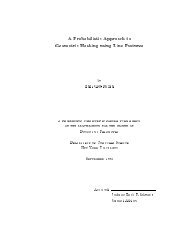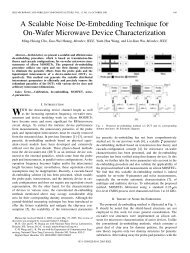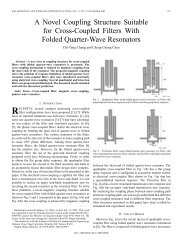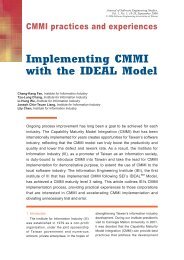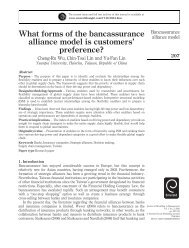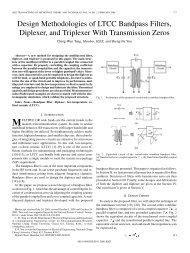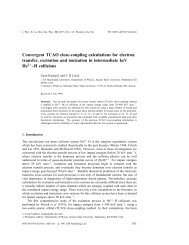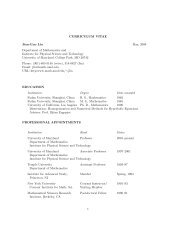Nonlinear dynamics induced by external optical injection in ...
Nonlinear dynamics induced by external optical injection in ...
Nonlinear dynamics induced by external optical injection in ...
Create successful ePaper yourself
Turn your PDF publications into a flip-book with our unique Google optimized e-Paper software.
780 T B Simpson et al<br />
The source of the near-Gaussian l<strong>in</strong>eshape can be determ<strong>in</strong>ed <strong>by</strong> analys<strong>in</strong>g the calculated<br />
time series for the carrier density equation. The carrier density fluctuations are proportional<br />
to refractive <strong>in</strong>dex changes through the dependence of the ga<strong>in</strong> on the carrier density. These<br />
fluctuations lead to <strong>in</strong>stantaneous variations <strong>in</strong> the cavity resonant frequency. A histogram of<br />
the frequency variations is also shown <strong>in</strong> figure 9. It is generated <strong>by</strong> count<strong>in</strong>g the number of<br />
times the frequency (carrier density) value falls with<strong>in</strong> a frequency b<strong>in</strong> <strong>in</strong>terval and plott<strong>in</strong>g<br />
the count as a function of frequency. This produces a spectrum with values proportional to<br />
the fraction of time that the particular frequency b<strong>in</strong> is the <strong>in</strong>stantaneous resonant frequency.<br />
Below threshold, the spectrum of resonance frequencies is relatively narrow. As threshold<br />
is approached, and the amplitude fluctuations of the laser field become suppressed through<br />
coupl<strong>in</strong>g with the carrier density, broaden<strong>in</strong>g sets <strong>in</strong>. Initially, the broaden<strong>in</strong>g is asymmetric,<br />
as shown <strong>in</strong> figure 9(a), reflect<strong>in</strong>g the <strong>in</strong>creased coupl<strong>in</strong>g of the field amplitude fluctuations<br />
to carrier density fluctuations for carrier densities closer to the threshold level. Above<br />
threshold, the broaden<strong>in</strong>g of resonance frequency fluctuations quickly <strong>in</strong>creases to a level<br />
where it saturates with further <strong>in</strong>creases <strong>in</strong> the pump level, as shown <strong>in</strong> figures 9(b) and (c).<br />
The distribution of resonance frequencies is dissimilar to the laser l<strong>in</strong>eshape <strong>in</strong> figures 9(a)<br />
and (c), but follows the same Gaussian profile <strong>in</strong> figure 9(b). At this pump level, it is the<br />
range of carrier density fluctuations that determ<strong>in</strong>es the laser l<strong>in</strong>eshape and not the usual<br />
phase diffusion fluctuations. The <strong>in</strong>stantaneous cavity resonance frequency fluctuations<br />
are caused <strong>by</strong> the same field noise source terms as the phase diffusion fluctuations, but<br />
usually they are not a significant factor <strong>in</strong> determ<strong>in</strong><strong>in</strong>g the l<strong>in</strong>eshape because the l<strong>in</strong>ewidth<br />
of each of the relaxation resonance features that forms the overall l<strong>in</strong>eshape is less than the<br />
resonance frequency. Therefore, the normal phase diffusion term reasserts its dom<strong>in</strong>ance<br />
above threshold even though the carrier density fluctuations persist. Only when the different<br />
relaxation resonance components show substantial overlap is there strong deviation from a<br />
central Lorentzian l<strong>in</strong>eshape.<br />
When the free-runn<strong>in</strong>g Gaussian l<strong>in</strong>eshape laser is subjected to <strong>external</strong> <strong>optical</strong> <strong><strong>in</strong>jection</strong><br />
several spectral changes occur. As before, we first concentrate on resonant <strong><strong>in</strong>jection</strong>. The<br />
first observable change as the <strong><strong>in</strong>jection</strong> level is <strong>in</strong>creased is a shift<strong>in</strong>g of the spectrum<br />
to lower <strong>optical</strong> frequencies. This reflects the drop <strong>in</strong> the overall carrier density due<br />
to the higher circulat<strong>in</strong>g field and enhanced stimulated emission. As the <strong><strong>in</strong>jection</strong> level<br />
is <strong>in</strong>creased further, the spectrum shows a new spike at negative offset frequencies and<br />
a dip at positive offset frequencies <strong>in</strong> addition to the overall shift and a spike at the<br />
<strong><strong>in</strong>jection</strong> frequency, as shown <strong>in</strong> figure 10(a). The free-runn<strong>in</strong>g spectrum is also shown for<br />
reference. The spike and dip are oppositely offset <strong>by</strong> 1 GHz—approximately the relaxation<br />
resonance frequency. As the excitation level is <strong>in</strong>creased further, spikes and dips appear<br />
at multiples of the orig<strong>in</strong>al offset. At higher excitation levels, the spectra are similar to<br />
the chaotic <strong>dynamics</strong> spectra discussed above, figure 10(b). F<strong>in</strong>ally, at very high excitation<br />
levels, the spectral structure has shifted away from the excitation peak and assumed a<br />
more Lorentzian l<strong>in</strong>eshape, figure 10(c). Calculated spectra show the progression from<br />
shift with spike and dip, figure 11(a), to chaotic-like, figure 11(b), to shifted Lorentzian,<br />
figure 11(c).<br />
We have previously presented the shift of the Fabry–Perot resonance feature due to<br />
<strong>optical</strong> <strong><strong>in</strong>jection</strong> when this laser was <strong>in</strong>itially biased at 3.9 mA, at the laser threshold [16].<br />
There, the <strong>in</strong>itial deviation from Lorentzian was not large, but the spectra clearly showed<br />
a narrow<strong>in</strong>g and a progression to a more Lorentzian l<strong>in</strong>eshape as the <strong>in</strong>jected power was<br />
<strong>in</strong>creased. This effect can also be seen as the laser frequency is tuned across the resonance<br />
at strong <strong><strong>in</strong>jection</strong> levels at the higher operat<strong>in</strong>g current described <strong>by</strong> the spectra presented<br />
here. Figure 12 plots this trend under strong <strong>external</strong> <strong><strong>in</strong>jection</strong>. For large positive detun<strong>in</strong>gs


